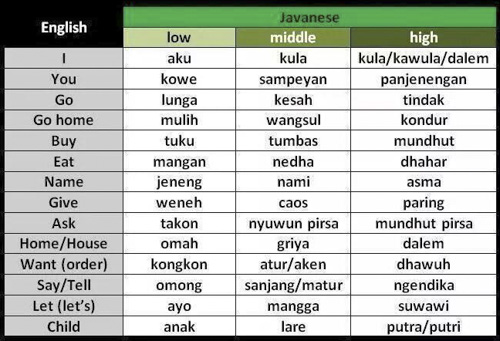Writing in the Javanese alphabet.
Written by Rebecca Schmor
About the Javanese Language
Javanese is a Malayo-Polynesian language spoken on the island of Java in Indonesia. Known locally as basa Jawa, Javanese is the language of the ethnic Javanese people, but the island is home to a variety of other ethnicities, such as Sundanese, Madurese, and Balinese. While the language that unites these different ethnic groups is usually Indonesian, people of other ethnicities also learn Javanese. This post features an interview with a Chinese-Indonesian speaker of Javanese, Christina Tjandra.
In this interview, Christina talks about her experience learning two of the three different varieties of Javanese: Ngoko and Krama Inggil. Ngoko is considered an informal variety of Javanese, while Krama Inggil represents politeness and formality and is used in the Royal Palace of Yogyakarta, in the Arts (e.g., in Javanese wayang performances), and when speaking to elders. The use of Ngoko (low), Krama (middle), or Krama Inggil (high) can also be related to status or class. Christina explains more in sharing her personal language-learning story below.

Interview with a Javanese Speaker
How did you learn Javanese?
Growing up, I spoke the East Javanese (Ngoko) dialect. I did not “learn it,” but I “acquired” it. We naturally mix Javanese Ngoko with Indonesian as part of our daily speech in East Java.
I adopted Ngoko because it is the type of Javanese my classmates used in our “playground language,” but we heavily blend it with Indonesian.
Until I was seven, my parents and I also lived with my grandparents, and they had a spice factory attached to their home. My grandma used Ngoko heavily in her daily speech to the factory workers. I picked this up quickly as a kid.
However, my parents do not speak Ngoko. My mom speaks Krama Inggil to her colleagues due to her position at the state university, but also to speak to anyone with Javanese background, including sellers in the market. It is a sign of respect, and they really appreciate this.
When I was young, I used to speak Ngoko very well due to school, but because I used Indonesian and English heavily at home, I lost my Ngoko as I grew older. To this day, I can still understand it, but I can no longer speak it.
I had to learn Krama Inggil in school because it is a part of our curriculum. Back then, I found it very hard, because it is like learning a totally different language! When I was home last Christmas, I picked up short Krama Inggil phrases that I used with my mom’s colleagues, or when I asked for directions in the street.

Are there any similarities between Javanese and Indonesian?
Ngoko, Krama Inggil, and Indonesian are like three totally different languages! They (often, but not always!) have the same rules, but we use completely different vocabularies. I find there is a slight overlap between Indonesian and Ngoko, as I was raised in East Java, and we mix Indonesian and Javanese Ngoko in our daily speech. But I noticed that when someone speaks to me about numbers greater than ten, I no longer understand them. I only know how to count up to ten in Ngoko and switch to Indonesian for eleven and up.
If someone speaks Krama Inggil to me, I won’t comprehend what they are saying just by knowing Indonesian or Ngoko. Perhaps I could pick up a couple words that I used to learn in school or through my mom’s language use, but not enough for me to fully understand and respond to communicate with others.
What is your favourite word or phrase in the Javanese language?
My favourite word is hanacaraka (this is the Javanese writing system)! I always found it to be so cool! I had to learn how to read and write hanacaraka throughout primary school.
My favourite phrase is “Alon alon asal kelakon” (go slowly but surely and steadily). This is like the phrase “slow and steady wins the race” in English from the tortoise and the hare story. The tortoise is “alon alon asal kelakon.”
Exploring Javanese Language Varieties
Description
This activity invites learners to listen to and analyze different Javanese dialectal varieties, while considering how knowledge of language varieties can improve language learning and development. The activity is designed for intermediate or advanced English language learners but can be adapted to other target languages or proficiency levels by translating or modifying the activity instructions and resources.
Steps
1. Analyzing Javanese language varieties (15–30 minutes)
Play part or all of the video “WIKITONGUES: Ayu speaking Javanese” and invite learners to take notes on the different dialects spoken by Ayu, using the chart below.
| Time | Questions | Answer Key |
| 0:00–0:56 | What Javanese dialect is Ayu speaking? | Ngapak |
| 0:56–1:13 | What differences do you notice when Ayu switches to Krama Inggil? | Much more formal tone, less wavering intonation, more formal body language |
| 1:49–2:52 | How does the Malang dialect sound in comparison to Ngapak? Can you notice when Ayu switches from Malang back to Ngapak? | More informal tone, higher pitch (switch happens at 2:47) |
| 3:52–4:02 | What do you notice about the way Ayu pronounces the word “Google”? Do you think she would pronounce this word differently in the other Javanese dialects? | She first pronounces it as a verb, goo-glay, and then as a noun, goo-gul; in both instances the stress is on the second syllable; it would probably not be pronounced differently because it is an internationally used loan word |
| 4:46–5:16 | What other language influences the Javanese dialect in Cirebon? | Sundanese |
| 5:16–6:08 | How does Ayu change her speech when describing how to speak to elders? | Switches to Krama Inggil, more formal and slightly softer tone |
As a possible extension, learners could be asked to listen to the video “WIKITONGUES: Nila speaking Javanese” and compare any perceived differences in the speaking styles of Ayu (a speaker of Central Javanese) and Nila (a speaker of Eastern Javanese).
2. Analyzing English language varieties (20 minutes)
Ask learners which varieties of English they are familiar with. Discuss examples of the different vocabulary, pronunciation, and syntactic structures used in different varieties, such as British English (e.g., “hoover” vs. “vacuum”), Canadian English (e.g., pronunciation of “water”), or African American Vernacular English (e.g., use of “was” for all past forms).
Invite learners to explore these and other features on YouGlish by selecting specific varieties of English (available options are United States, United Kingdom, Australia, Canada, Ireland, Scotland, or New Zealand) and searching for certain words or phrases (e.g., “water”) to listen to and compare the different varieties.
3. Discussing dialectal language varieties (10 minutes)
Invite learners to reflect on steps 1 and 2 by discussing general features, similarities, and differences they have observed among dialectal varieties of a language. Encourage learners to refer to examples from other languages they are familiar with. Depending on the course, the discussion could include critical reflection on the stigmatization or prestige of certain dialects and speakers, and the importance of preserving linguistic diversity through dialectal language use.
Commentary
This activity encourages engagement with the concept of language varieties through interaction with dialectal features in the target language and other languages. Being exposed to, and working to understand, different language varieties is a crucial skill for language learners. In an increasingly globalized world, learners will interact with many different varieties and speakers of a language. This is especially true for colonial languages like English.
As such, the exploration of the features of English language varieties can also support an English as a Lingua Franca approach to instruction, which prioritizes intelligibility in using English among speakers of other languages. Further, including non-target language varieties in the classroom supports a plurilingual view of language learning and development, valuing linguistic diversity while promoting the recognition of dialects.
Further Reading
Council of Europe. (2023). Plurilingualism and pluriculturalism. https://www.coe.int/en/web/common-european-framework-reference-languages/plurilingualism-and-pluriculturalism
Simpson Davies, K., & Patsko, L. (2013). How to teach English as a lingua franca (ELF). British Council. https://www.britishcouncil.org/voices-magazine/how-teach-english-lingua-franca-elf




